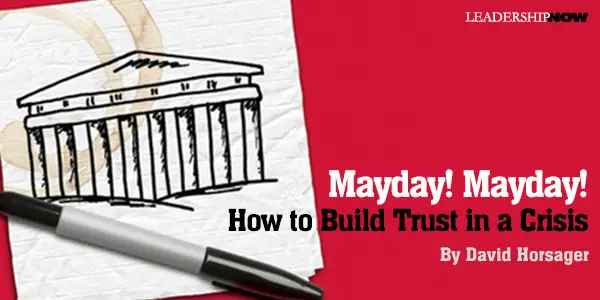 |
 |
04.09.21

Mayday! Mayday! How to Build Trust in a Crisis
NOTHING reveals an organization’s limits more than a sudden crisis. And after 2020, we’ve all become more familiar with what that looks like. Crisis situations test what you have built — your culture, your relationships, your resilience. But at the root of all of these challenges is one capacity that means the difference between success and failure: trust. Trust is your most important asset amidst crisis and change. A team with high levels of trust will have the agility necessary to make decisions and react quickly to fluctuating situations. Building Trust Instantly The beautiful thing about trust is that it will help you through a crisis even if you start to build it the day things go off the rails. In fact, your quickest opportunity to build trust is in a crisis. On 9-11, complete strangers trusted each other in an instant if they were running in the same direction. To some degree, trust is built up over time, but your ability to build trust multiplies in a crisis. Building trust consists of strengthening eight traits (also called pillars) that came out of research on what makes the most effective leaders and organizations. Take a look at the pillar of clarity for example. Clarity increases trust instantly. It’s almost impossible to trust a leader who is vague or who gives insufficient information. But be crystal clear in your words and your actions, and trust will immediately increase — especially in the middle of a crisis. This three-point strategy prioritizes clarity and provides a roadmap that you can use over and over in any crisis. 1. Narrow your focus to a single priority. When the unexpected hits, everything feels like a priority. But it’s actually the opposite; in a crisis, it’s essential to address only one priority at a time. Ask yourself these two questions to help guide your actions: first, ask “What can I control?” It’s tempting to focus on barriers, but the only thing that matters in a crisis is what you can control, not what you can’t. The second question to ask yourself is “What is the one, most important thing that I can do, right now?” That’s your priority. Designating only one priority means your team will be able to follow through. There’s nothing that builds clarity more effectively than aligning a team around a single, achievable priority. When your team knows exactly where to focus its efforts, trust in your leadership will grow. 2. Compress your plan into short blocks. In a conversation with Gen. McChrystal (best known for his leadership of the US Army Joint Special Operations Command), he shared that when the war in Afghanistan took a turn for the worse, they weren’t able to quickly get the intel they needed. So instead of planning weeks ahead, they set 30-minute daily meetings to define a daily priority. What could this look like in business? Often leaders set a one-year priority, but in a crisis the pace of change means you may need to set a one-month, one-week, or even a one-day priority for your people to follow. In any crisis, task completion is a crucial benchmark because momentum builds momentum. Narrow your priority to something that can be completed in this short timeframe, or shorter! After a week, the situation may have completely transformed. A doable goal also facilitates engagement and optimism. When people know absolutely that their efforts are aligned with a larger plan, they won’t have to waste precious time second guessing or asking for approval. Nothing solidifies trust like a reliable pattern of completion. And the more trust increases, the more smoothly and quickly your operation can run. 3. Maintain agility. Responding to a crisis requires speed, but it also requires flexibility and agility. The situation will change constantly and on a massively accelerated timeframe. The ability to take in information, adjust, and pivot to a new direction is crucial. Once you’ve completed one priority, you need to be able to identify and shift to the next one. The ability to reassess a situation and pivot quickly is just as important as narrowing to a single focus. Leaders must be actively engaged in this process, taking their teams from start to finish, then circling back around to repeat the process. Making it through a crisis unscathed requires organizations to be able to identify, complete, and move on from tasks at a rapid clip. A high trust organization will always be able to move more quickly and maintain solid footing. And nothing facilitates trust better than crystal clear communication. Once you start, clarity builds on itself, and as clarity increases, trust grows exponentially in your leadership and in your business.  
Posted by Michael McKinney at 12:52 PM
|
BUILD YOUR KNOWLEDGE
 

How to Do Your Start-Up Right STRAIGHT TALK FOR START-UPS 
Grow Your Leadership Skills NEW AND UPCOMING LEADERSHIP BOOKS 
Leadership Minute BITE-SIZE CONCEPTS YOU CAN CHEW ON 
Classic Leadership Books BOOKS TO READ BEFORE YOU LEAD |